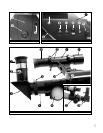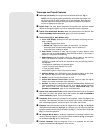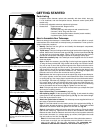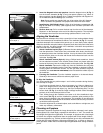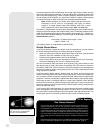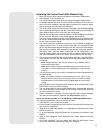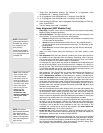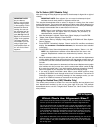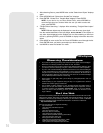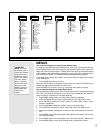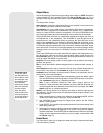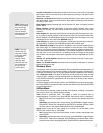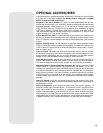
13
Go To Saturn (NGC Models Only)
After performing the Easy Alignment procedure, the telescope is aligned for a night of
viewing.
IMPORTANT NOTE: Once aligned, do not move the telescope's tripod
and base from the level position or alignment will be lost.
This exercise demonstrates how to select an object for viewing from the control
panel's Object menu. The control panel provides an Object menu which displays a list
(sometimes called a database) of over 1400 objects you can view with your telescope.
This example demonstrates how to select Saturn from the list.
NOTE: Saturn is not visible the entire year and you may need to choose
another object from the Object menu list; however, the procedure, as
described below, remains the same.
1 After the telescope is aligned, "Select Item: Object" displays. Press ENTER.
2. "Object: Solar System" displays. Press ENTER.
3. "Solar System: Mercury" displays. Keep pressing UP/DOWN until "Solar System:
Saturn" displays.
4. Press ENTER. "Calculating" displays. "Saturn" and its R.A. and Dec. coordinates
display. See
APPENDIX A: ADVANCED FEATURES, for information about celestial
coordinates.
5. Press ENTER. Next, Saturn's displacement numbers display: "Saturn: +14 -135."
NOTE: Your displacement numbers will be different than the ones in this
example. Displacement numbers are determined by location, time, and
date.
6. Move the telescope tube to the right or left until you notice the first displacement
number getting smaller. Keep moving the tube until the number reaches zero. As
you near zero, use the horizontal slow motion control (
20, Fig. 2) to move the opti-
cal tube.
Next, move the tube upward or downward until the second displacement number
also reaches zero. As you near zero, use the vertical slow motion control (
F, Fig.
3
) to move the optical tube. If you performed the alignment procedure correctly,
Saturn will appear in your eyepiece. You may need to center the image.
7. If you wish to display information about Saturn, press MODE and then keep
pressing UP/DOWN to scroll through various lines of information. The last line of
information displays as a scrolling message. As the message scrolls, you can
press UP or DOWN to increase or decrease the scrolling speed.
Using the Guided Tour (NGC Models Only)
The control panel provides a Guided Tour menu that displays the best objects (and
their displacement numbers) to view on any given night of the year. This example
demonstrates how to use the "Tonight’s Best" Guided Tour. Other Guided Tours are
also provided.
Which One’s the Alignment Star?
If the control panel has chosen an alignment star with which you are unfamiliar,
how can you be sure if the star in your eyepiece is really the alignment star?
The rule of thumb is that an alignment star is usually the brightest star in that
area of the sky. If you're not sure if you have located the alignment star or it isn't
in the eyepiece, look through your viewfinder. When you view an alignment star
in the viewfinder, it stands out dramatically from the rest of the stars in that por-
tion of the sky. The viewfinder will help you locate a star more quickly than the
eyepiece, because it has a much wider field of view than the eyepiece.
If you have an obstruction, such as a tree or a building blocking your view of the
alignment star, or if you have any doubts at all about the star that has been cho-
sen, no problem. Just press UP/DOWN and the control panel will find another
star to align upon.
TIPS for Beginners
IMPORTANT NOTE:
As you observe
Saturn, you will notice
that the image moves
in the eyepiece.This is
because the Earth is
rotating.You can use
the horizontal and ver-
tical slow motion con-
trols (
20, Fig. 2 and F,
Fig. 3) to re-center the
image in the eyepiece.
The image will move
much faster if you are
using a higher-pow-
ered eyepiece such as
a 4 mm or the 12mm
eyepiece.



